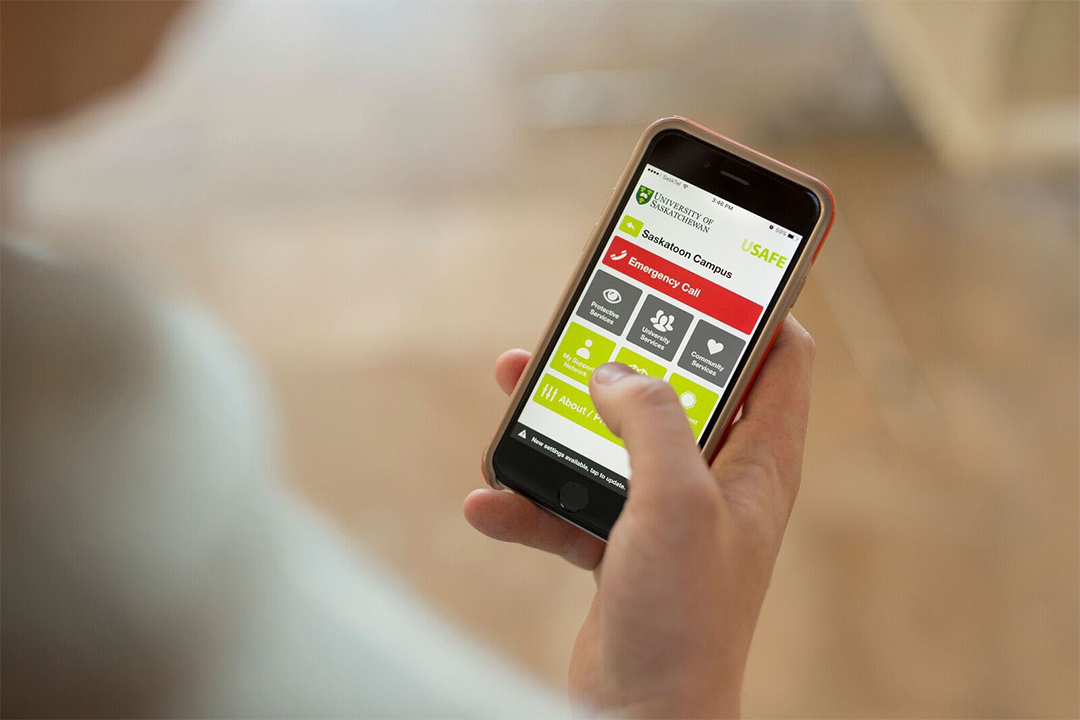
USAFE app simplifies safety procedures
Knowing how to react after being the victim of a crime can be an overwhelming, emotional task.
By Meghan SiredTo help simplify the process for those affected by crime or during an emergency, the University of Saskatchewan launched a safety app called USAFE last fall.
The USAFE app features emergency contact information, safety tips, a way to ask a friend to virtually walk you home, as well as an emergency alert component. It also includes an interactive campus map, webcam views of campus, links to local transportation, and the ability to send your location to a friend via text or email.
“We wanted to create a clean, simple interface that you could use quickly,” said Peter Hedley, director of support services within the Vice-Provost Teaching and Learning portfolio. “Our main priority with the app is to increase awareness of, and access to, university supports and to allow quick access to information on what actions to take during an emergency.”
The university worked with a Toronto-based company, AppArmor, to develop the app. Hedley said the company was already in discussions with Ata Merat, the 2015/16 vice-president of operations and finance at the U of S Students’ Union (USSU). The project was then taken forward by Hedley and Merat’s successor, Emmanauel Barker.
“This was a genuine campuswide collaboration. With my newness to the role and the university, it genuinely surprised me how many parts of the university the project touched, as well as how many people on campus wanted to support us,” said Hedley.
The app also features content for use on U of S campuses in Prince Albert and Regina. When the app opens, users are prompted to select their location, with the features and contact information changing depending on what was selected.
“Those campuses can sometimes be out of sight and out of mind for those of us in Saskatoon, and it’s important for us to remember that there are literally hundreds of students and many faculty and staff on those campuses,” said Hedley. “They have the same safety needs as any other student or employee.”
Barker said the most tangible part of the app is the “emergency call” button, which is bright red on the front page. Once the button is selected, USAFE locates the phone and, depending on the location, will dial Protective Services or 911.
“The university can be a difficult place to navigate in person and online, and this app makes everything so much easier,” said Barker. “When you’re nervous or you’re in shock, you need to have all of that information at your fingertips. There’s no time to search for help.”
In the 2016 National College Health Association survey, 12 per cent of female U of S students (and 57 per cent of male students) said they felt very safe on campus at night.
That dropped to nine per cent for females (and 38 per cent for males) when asked how they felt in the broader community at night.
According to Harold Shiffman, associate director of Protective Services, those numbers will likely increase the more self-aware we feel. To Shiffman, being more self-aware from a safety perspective means a person takes initiative to find tools or information to feel safer.
“Learning what to look for in a high quality bike lock, choosing not to leave your valuables unattended, reading lock-down procedures on the USAFE app, are all self-aware, empowering behaviours,” said Shiffman. “Our campus is a big place, so using USAFE to quickly identify your location, and knowing that Protective Services is just a button-press away, will be beneficial to everyone on campus—student, staff and visitor alike.”
According to Shiffman, the USAFE app is part of the university’s multi-device emergency alert system. In an emergency, users with the USAFE app will receive the alerts on their mobile device. Alerts will also be broadcast on yellow Alertus beacons on campus, on all Cisco IP phones, on digital display screens and on university-managed desktop computers.
Hedley said he is looking forward to developing USAFE further to meet users’ needs. He is also looking into developing more functionality around discrimination, harassment and assault, which will allow a user to go through a “decision tree” to navigate some of the key considerations and resources to support their welfare, safety and response to a crisis.
Download USAFE at the Apple App Store or Google Play. Send feedback about the app to usafe.feedback@usask.ca.
Meghan Sired is a communications co-ordinator within the vice-provost teaching and learning portfolio.

